Top ERP Systems in 2025 and How They Differ
In 2025, the landscape of enterprise resource planning (ERP) has evolved significantly. Businesses of all sizes are searching for the top ERP systems in 2025 to streamline operations, reduce costs, and scale more efficiently. With AI integration, industry-specific modules, and cloud-first architecture becoming the standard, the ERP market is more diverse and competitive than ever.
This guide breaks down the leading ERP platforms of 2025 and highlights how they differ in functionality, target markets, pricing models, and customizability.

1. SAP S/4HANA
Overview:
SAP remains a powerhouse in the ERP space, especially for large enterprises. S/4HANA runs on SAP’s in-memory database, offering real-time analytics and improved performance over legacy systems.
Key Features:
AI-driven automation
Advanced financial planning tools
Industry-specific configurations (e.g., manufacturing, healthcare)
What Sets It Apart:
SAP’s ecosystem and robust global support make it ideal for multinationals with complex regulatory needs.
2. Oracle NetSuite
Overview:
Oracle NetSuite remains one of the most widely used cloud-based ERP systems among small to mid-sized businesses in 2025.
Key Features:
Unified suite for ERP, CRM, and e-commerce
Multi-entity support with global tax compliance
Scalable modules and real-time dashboards
What Sets It Apart:
NetSuite is built for fast-growing businesses and offers excellent scalability without the burden of on-premise infrastructure.
3. Microsoft Dynamics 365
Overview:
A strong contender in both mid-market and enterprise segments, Microsoft Dynamics 365 continues to shine with tight integration across Microsoft’s ecosystem.
Key Features:
Seamless integration with Microsoft 365 and Power BI
Modular apps (Finance, Supply Chain, HR)
AI insights and predictive forecasting
What Sets It Apart:
User-friendly interface and lower learning curve, especially for businesses already invested in Microsoft tools.
4. Odoo
Overview:
Odoo has made significant leaps in 2025 by catering to SMBs that require modular, open-source ERP systems at an affordable price point.
Key Features:
Open-source customization
40+ integrated business apps
Cost-effective and developer-friendly
What Sets It Apart:
Unparalleled flexibility with open-source access, making it highly customizable for niche industries or startups.
5. Infor CloudSuite
Overview:
Infor has doubled down on cloud-first industry-specific solutions. CloudSuite offers tailored ERPs for manufacturing, healthcare, and distribution.
Key Features:
AI-driven supply chain tools
Industry-specific cloud environments
Deep analytics and IoT integration
What Sets It Apart:
Infor’s vertical market strategy makes it ideal for organizations seeking solutions that already understand their industry nuances.
6. Acumatica
Overview:
A cloud-native ERP designed with growing mid-market businesses in mind, Acumatica continues to gain traction due to its flexible pricing model and usability.
Key Features:
Unlimited user pricing
Modern API-based integrations
Strong mobile and remote access features
What Sets It Apart:
Acumatica’s usage-based pricing is a standout, allowing unlimited users and charging based on resources used instead.
Workday
Overview:
Workday leads in ERP for human capital management (HCM) and financials, particularly in education, healthcare, and government sectors.
Key Features:
Machine learning for workforce planning
Intuitive user interface
Cloud-native with strong compliance tracking
What Sets It Apart:
Best-in-class HCM modules, making it the go-to choice for talent-heavy organizations that prioritize workforce optimization.
How These ERP Systems Differ
Target Market:
SAP and Oracle serve large enterprises.
NetSuite, Acumatica, and Odoo focus on SMBs and mid-market.
Workday excels in HCM-heavy verticals like education and healthcare.
Deployment Options:
Most top ERPs in 2025 are cloud-native, but SAP still offers hybrid options for complex environments.
Odoo provides on-premise and cloud flexibility.
Customization and Flexibility:
Odoo and Acumatica are developer-friendly.
SAP and Oracle offer rich features but often require costly custom development.
Cost Structure:
Acumatica’s resource-based pricing stands out.
Odoo is budget-friendly for small teams.
Microsoft Dynamics offers modular licensing for cost control.
Integration and Ecosystem:
Microsoft Dynamics offers the tightest integration with productivity tools.
Oracle and SAP have vast ecosystems but may require more complex onboarding.
Choosing the right ERP depends on your business size, industry, and internal capabilities. The top ERP systems in 2025 vary widely in pricing, scalability, and specialization, which gives businesses more choice—but also requires a more informed selection process.
Be sure to evaluate not just features, but long-term support, integration needs, and future scalability when choosing your ERP solution.
